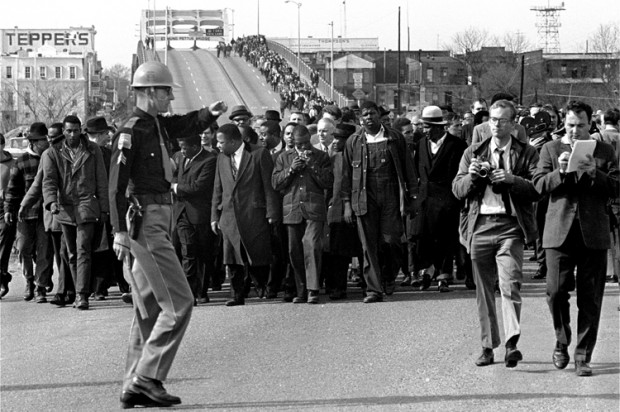 Can I speak honestly about the new movie, “Selma?”
Can I speak honestly about the new movie, “Selma?”
No doubt, it’s going to get a lot of support for an Oscar. Critics have raved about it, calling it a “must-see.” I agree—it’s definitely worth seeing. A lot of people are going to buy tickets because the subject matter is important—Dr. Martin Luther King Jr.’s historic, game-changing, 1964 protest march from Selma to Montgomery, Alabama. Many movie-goers of a certain age—I’m one of them—will remember those events and the people who made them happen—and it will take us back to a time when the courageous struggle for voting rights and equality ultimately brought hope for a better America.
The acting is good. The cinematography is good.The story is, without question, one that needs to be told and retold—and one that younger people need to know about.
The most powerful scene in “Selma” is the depiction of the Selma-to-Montgomery march itself. The first effort to cross the bridge ended in a violent response by Alabama State Troopers and local police, which was broadcast widely on news reports and emblazoned on the front pages of newspapers around the world. A few days later, King and the other organizers marched again—this time joined by thousands of protesters—black and white—who streamed in from all over the U.S. I was 18 when I saw that, and today, it brought tears to my eyes again.
But here’s the but. “Selma” could have been better. I’m going to take some heat for criticizing this movie, I know, because this is one of those movies that we are expected to admire and love, carte blanche.
On the plus side, the movie purports to show us not just the march itself, but also the politics, negotiations, outrages and emotions that took place behind the scenes. I appreciate that effort, and it helped to get a glimpse of the context behind such a key event in a world-changing movement. [My spouse and I found ourselves mentally tagging the players: John Lewis, James Farmer, Viola Liuzzo, James Reeb, Hosea Williams, Andrew Young, Diane Nash —names we remember from news coverage of the day, but who were only tangentially identified in the script. Younger viewers unfamiliar with the details may wish they had a scorecard.]
But as the story progressed, I just didn’t buy the dialogue. In an attempt to ensure that the movie comes off as serious, the writers overwrote. Unfortunately, almost all of the characters speak in what sounds more like speeches than conversations. They’re being poetic, not talking. Everyone is grammatically correct and fluent, and most—even at their most heated moments—speak in paragraphs. It reminded me, in tone, of the stilted, overly patriotic language we used to endure in educational films about American history.
The most egregious example is the dialogue assigned to Tom Wilkinson, a British actor playing President Lyndon Johnson. Wilkinson is an excellent actor, and his American accent—although not Texan enough for Johnson—is fine. But it’s well known that Johnson was a very plain speaker who peppered his private conversations with all manner of profanities and homey analogies. In “Selma,” with the one exception of a curse-word-laden harangue with Alabama Governor George Wallace, Johnson is far too formal and diplomatic in his conversations. To me, that undermines the movie’s credibility.
All of that being said, I left the movie with several takeaways.
Regarding historical accuracy, I was surprised—echoing many critics–at how the writers characterized President Johnson as being reluctant to help Dr. King in his quest for voting rights. I am going to have to look that up, as well as whether Johnson—as is implied in the movie—enlisted the aid of FBI director J. Edgar Hoover [who saw Dr. King as a threat to his sense of order] to try to undermine the movement.
More broadly, I’m left with the lesson that police over-reaction has, through the years, been one of the most powerful, though unintentional, factors in the progress of reform movements. What got white America on the side of King and the protestors? Seeing Sheriff Bull Connor’s fire hoses and attack dogs. Watching Sheriff Jim Clarke’s baton-wielding, head-banging police attack peaceful marchers on the Edmund Pettus Bridge. It was a lesson that King learned well and used to the civil-rights movement’s advantage.
And that lesson, unfortunately, is still in effect. We’ve seen it again and again: in the Ferguson and St. Louis County Police Departments’ over-reaction to protests in the death of Michael Brown; and in the viral video of the choke-hold killing of Eric Garner for protesting his arrest for selling loose cigarettes. Sadly, fifty years after TV viewers watched police billy-clubbing marchers in Selma, Alabama, we are still witnessing the same kind of behavior. You’d think law-enforcement officials would have learned, by now, that these actions are counter-productive. But, in some perverse way, people working for change can be thankful that they keep doing this stuff.
It’s sad, too, to realize that 50 years later, the big success brought about by the Selma march—the Voting Rights Act of 1965—has been, essentially, gutted by the conservative-led U.S. Supreme Court. The 1965 law required that lawmakers in states with a history of discriminating against minority voters get federal permission before changing voting rules. In 2014, Chief Justice John Roberts voted to gut the Voting Rights Act on the basis that “our country has changed,” and that blanket federal protection wasn’t needed to stop discrimination. States previously governed by the now-gutted section of the law immediately began rolling back voting rights.
We can view “Selma” as a history lesson. We can applaud Hollywood’s willingness to, at long last, support and possibly honor a movie that is at least somewhat realistic in depicting that painful period in 20th century America. But we must also see it as a cautionary tale: Things haven’t changed enough, and the struggle is far from over.
The post Takeaways from “Selma” appeared first on Occasional Planet.